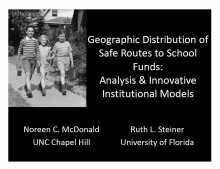We are pleased to announce an exciting new alliance between Active Living Research and GP RED to co-host and coordinate...
Geographic Distribution of Safe Routes to School Funds: Analysis & Innovative Institutional Models

Presentation at the 2010 Active Living Research Annual Conference
Background:
Advocates have raised concerns that minority and low-income communities, where rates of walking to school are the highest, have been disadvantaged in applying for Safe Routes to School funds due to a lack of community capacity to collect data and apply for grants.
Objectives:
This analysis conducted the first empirical assessment of the spatial distribution of SRTS funds and identified institutional models for state implementation of this federal mandate.
Methods:
Data - Information on funded SRTS projects, including location, type of intervention, and grant amount, was obtained from the National Center for SRTS for all states and the District of Columbia (n=51); data on projects that applied for SRTS funds but were unfunded were obtained from the state Departments of Transportation where available (n=9). Demographic characteristics of census tracts were obtained for the US from Census 2000; school demographic information came from the National Center for Education Statistics. Telephone interviews with 48 of the 51 state SRTS coordinators detailed information about the organization of the state SRTS program and identified innovative models for reaching out to low-income and minority communities.
Analysis - Funded and unfunded SRTS projects were geocoded to identify the school and census tract where the project was located. T-tests analyzed whether there are significant differences in demographic characteristics (median household income, percent living below the poverty line, percent Hispanic, percent non-Hispanic black, percent non-Hispanic white, percent Asian) between schools and tracts receiving SRTS funds and those that do not receive funds. For states with information on unfunded SRTS projects, we tested for demographic differences between areas that did not apply for SRTS funds and those that did apply, and between areas that applied and areas that were funded.
Results:
Preliminary analysis of the GIS data shows some significant differences in the racial and ethnic composition of areas receiving SRTS funds and those who have not received funds. However, this analysis is still in progress and will be finished by the end of the summer 2009.
Most SRTS coordinators acknowledged the need to conduct outreach to low-income areas. In general, they defined low-income areas as rural areas and felt that poor, urban areas had enough resources to apply for SRTS funds (through the local metropolitan planning organization or the school district). Most states did not conduct targeted outreach to low-income and minority communities. Instead, they reported doing trainings “around the state,” particularly emphasizing those areas that had been under-represented in SRTS applications. However, Massachusetts and Michigan have pilot programs funded through foundations to help urban schools apply for and implement SRTS programs. The SRTS program in both states is managed on a day-to-day basis by non-profit service providers and not the Department of Transportation. This model of contracting with a dedicated SRTS service provider for outreach may have advantages in other states.
Conclusions:
The analysis showed that state SRTS coordinators are aware of the need to do outreach on the program to all groups. However, their schedules often do not allow for targeted outreach to low-income and minority groups. A more promising model, in larger states, is a centralized SRTS service provider which can help local areas navigate the DOT process and respond more nimbly to the need to do outreach in low-income and minority communities. This may suggest a role for non-governmental organizations in ensuring that children can receive the benefits of the SRTS irrespective of the demographics of their neighborhood.
Support:
This projected was supported by a Round 8 grant from the Robert Wood Johnson Foundation’s Active Living Research Program.
Related Tools & Resources
STAY UP TO DATE
RECENTLY ADDED TOOLS & RESOURCES
MOVE! A BLOG ABOUT ACTIVE LIVING
The "Active Living Conference" aims to break down research and practice silos and...







